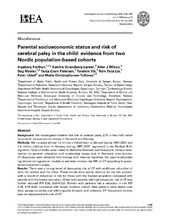Parental socioeconomic status and risk of cerebral palsy in the child: evidence from two Nordic population-based cohorts
Forthun, Ingeborg; Strandberg-Larsen, Katrine; Wilcox, Allen J; Moster, Dag; Petersen, Tanja Gram; Vik, Torstein; Lie, Rolv T.; Uldall, Peter; Tollånes, Mette Christophersen
Peer reviewed, Journal article
Published version

Åpne
Permanent lenke
https://hdl.handle.net/1956/19020Utgivelsesdato
2018-06-26Metadata
Vis full innførselSamlinger
Originalversjon
https://doi.org/10.1093/ije/dyy139Sammendrag
Background We investigated whether the risk of cerebral palsy (CP) in the child varies by parents’ socioeconomic status, in Denmark and Norway. Methods We included almost 1.3 million children born in Demark during 1981–2007 and 2.4 million children born in Norway during 1967–2007, registered in the Medical Birth registries. Data on births were linked to Statistics Denmark and Norway to retrieve information on parents’ education and relationship status and, in Denmark, also income. CP diagnoses were obtained from linkage with national registries. We used multivariate log-binominal regression models to estimate relative risk (RR) of CP according to parental socioeconomic status. Results There was a strong trend of decreasing risk of CP with additional education of both the mother and the father. These trends were nearly identical for the two parents, with a one-third reduction in risk for those with the highest education compared with parents with the lowest education. When both parents had high education, risk of CP was further reduced (RR 0.58, 0.53–0.63). Women with partners had a reduction in risk (RR 0.79, 0.74–0.85) compared with single mothers overall. Risk patterns were stable over time, across countries and within spastic bilateral and unilateral CP. Household income was not associated with risk of CP. Conclusions Risk of CP in two Scandinavian countries was lower among educated parents and mothers with a partner, but unrelated to income. Factors underlying this stable association with education are unknown, but could include differences in potentially modifiable lifestyle factors and health behaviours.
